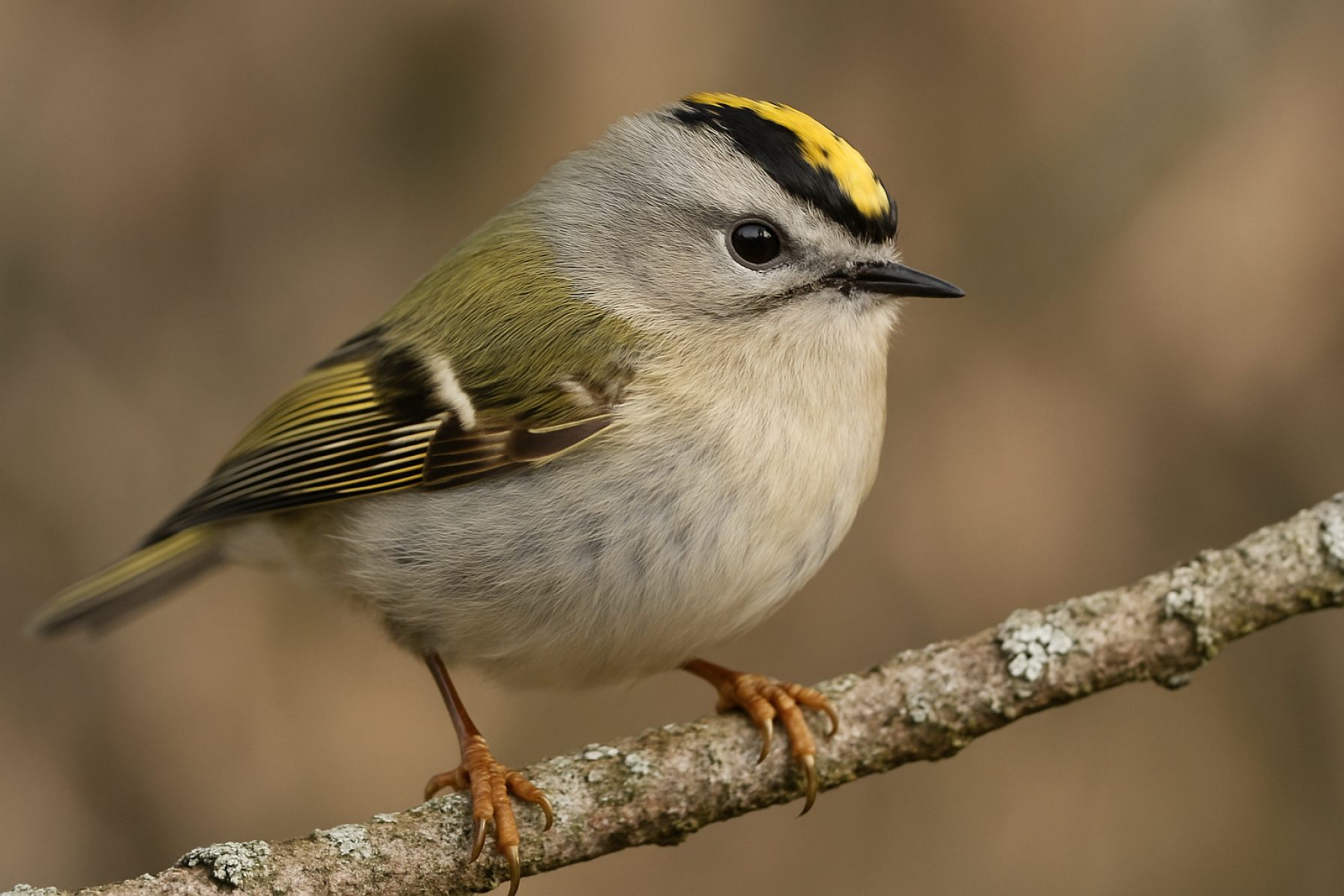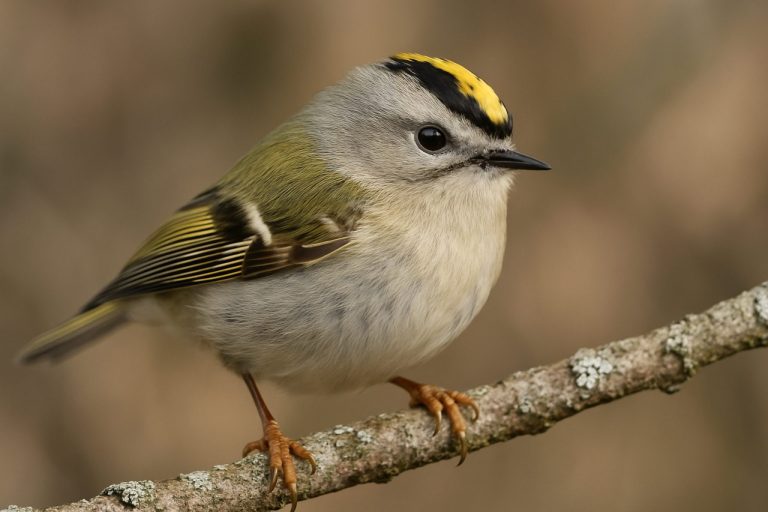
Inside the Secret Lives of Kinglets: How Regulus Species Defy Size with Survival Skills and Song. Discover Why These Tiny Birds Are Captivating Ornithologists and Birdwatchers Worldwide. (2025)
- Introduction: Meet the Kinglets—Regulus Genus Overview
- Taxonomy and Evolutionary Origins of Kinglets
- Physical Adaptations: Surviving as the Smallest Songbirds
- Vocalizations and Communication: The Science of Kinglet Song
- Habitat Preferences and Global Distribution Patterns
- Breeding Behavior and Life Cycle Insights
- Kinglets in Ecosystem Dynamics: Roles and Interactions
- Conservation Status and Threats (Citing birdlife.org, iucn.org)
- Technological Advances in Kinglet Research (Bioacoustics, Tracking, Genomics)
- Future Outlook: Public Interest, Citizen Science, and Projected Growth in Kinglet Studies (+30% by 2030, per increased eBird and iNaturalist data from cornell.edu and inaturalist.org)
- Sources & References
Introduction: Meet the Kinglets—Regulus Genus Overview
The kinglets, belonging to the genus Regulus, are among the smallest songbirds in the world, captivating ornithologists and bird enthusiasts alike with their diminutive size, energetic behavior, and distinctive plumage. The genus Regulus is part of the family Regulidae and comprises several species distributed across the Northern Hemisphere, including Europe, Asia, and North America. Notable members include the Goldcrest (Regulus regulus), often recognized as Europe’s smallest bird, and the Ruby-crowned Kinglet (Regulus calendula), a familiar sight in North American woodlands.
Kinglets are characterized by their tiny, rounded bodies, short tails, and thin, pointed bills. Adults typically measure between 8 and 11 centimeters in length and weigh only 5 to 7 grams. Despite their size, kinglets are remarkably active, constantly flitting through foliage in search of insects and spiders, which form the bulk of their diet. Their plumage is generally olive-green with pale underparts, but they are best known for the bright, crown-like patches on their heads—golden in the Goldcrest and fiery red in the Ruby-crowned Kinglet, though the latter is usually concealed except during displays.
The genus Regulus is of particular interest to ornithologists due to its evolutionary adaptations for survival in cold climates. Kinglets possess a high metabolic rate, enabling them to maintain body heat even in freezing conditions. Their nests, often intricately woven and well-insulated, further protect their eggs and young from the elements. These adaptations have allowed kinglets to thrive in a variety of habitats, from boreal forests to temperate woodlands and even urban parks.
Taxonomically, the genus Regulus has been the subject of ongoing research, with molecular studies helping to clarify relationships within the group and with other songbirds. The family Regulidae is now recognized as distinct from other small insectivorous birds, such as the Old World warblers, based on genetic and morphological evidence. Conservation organizations, including BirdLife International and Cornell University’s ornithology department, monitor kinglet populations and provide resources for their study and protection.
In summary, kinglets of the genus Regulus are remarkable for their size, resilience, and ecological significance. Their widespread distribution and unique adaptations make them a fascinating subject for both scientific research and birdwatching communities worldwide.
Taxonomy and Evolutionary Origins of Kinglets
The kinglets, belonging to the genus Regulus, are a group of diminutive passerine birds renowned for their vibrant plumage and high-pitched songs. Taxonomically, kinglets are classified within the family Regulidae, which is distinct from other small songbirds such as warblers and tits. The genus Regulus comprises several species, including the well-known goldcrest (Regulus regulus) and the ruby-crowned kinglet (Regulus calendula). Historically, kinglets were sometimes grouped with the Old World warblers (family Sylviidae) due to superficial similarities in size and behavior. However, advances in molecular phylogenetics have clarified their unique evolutionary lineage, supporting their placement in a separate family, Regulidae.
The evolutionary origins of kinglets trace back to the early diversification of passerine birds. Genetic studies indicate that the Regulidae diverged from other passerines during the Miocene epoch, approximately 10–20 million years ago. This divergence is supported by both mitochondrial and nuclear DNA analyses, which reveal that kinglets form a monophyletic group distinct from other songbird families. The genus Regulus is believed to have originated in the Palearctic region, with subsequent dispersal events leading to the colonization of North America by the ruby-crowned kinglet. The biogeographical history of kinglets reflects patterns of migration and adaptation to temperate and boreal forests across Eurasia and North America.
Morphologically, kinglets are characterized by their tiny size, rounded wings, and distinctive crown patches—features that have remained relatively conserved throughout their evolutionary history. The genus name Regulus is derived from the Latin word for “little king,” referencing the bright crown markings found in most species. These features, along with their unique vocalizations and nesting behaviors, further distinguish kinglets from other passerines.
The current taxonomic consensus, as maintained by leading ornithological authorities such as the British Ornithologists' Union and the American Ornithological Society, recognizes six to seven extant species within the genus Regulus. Ongoing research, including genomic sequencing and comparative morphology, continues to refine our understanding of kinglet taxonomy and their evolutionary relationships within the broader context of avian diversity.
Physical Adaptations: Surviving as the Smallest Songbirds
Kinglets, belonging to the genus Regulus, are among the smallest songbirds in the Northern Hemisphere, with adults typically weighing between 4 and 7 grams and measuring just 8 to 11 centimeters in length. Their diminutive size presents unique physiological and behavioral challenges, particularly in terms of thermoregulation, energy conservation, and predator avoidance. Over evolutionary time, kinglets have developed a suite of physical adaptations that enable them to thrive in diverse and often harsh environments, from boreal forests to temperate woodlands.
One of the most critical adaptations of kinglets is their exceptionally high metabolic rate. Due to their small body mass and large surface area relative to volume, kinglets lose heat rapidly, especially in cold climates. To compensate, they maintain a resting heart rate that can exceed 600 beats per minute and a body temperature around 40°C. This high metabolism allows them to generate sufficient internal heat, but it also necessitates near-constant foraging for energy-rich insects and spiders, even during winter months. Their ability to glean tiny arthropods from foliage and bark is facilitated by their slender, pointed bills and agile movements.
Kinglets also possess specialized plumage that provides both insulation and camouflage. Their feathers are dense and fluffy, trapping air close to the body to minimize heat loss. During cold nights, kinglets often engage in communal roosting, huddling together in dense foliage to share body warmth and further reduce energy expenditure. This behavior is particularly important for species such as the Goldcrest (Regulus regulus) and Ruby-crowned Kinglet (Regulus calendula), which inhabit regions with severe winters.
In addition to thermal adaptations, kinglets exhibit remarkable agility and maneuverability in flight. Their short, rounded wings and lightweight bodies enable rapid, darting movements through dense vegetation, aiding in both foraging and evasion of predators. Their cryptic coloration—olive-green or grayish upperparts with subtle wing bars and a distinctive crown patch—helps them blend into their surroundings, reducing the risk of detection by predators.
These physical adaptations, combined with behavioral strategies such as high foraging rates and social roosting, allow kinglets to survive and reproduce successfully despite the challenges posed by their small size and the environments they inhabit. Their resilience and adaptability make them a fascinating subject for ornithological research and conservation efforts by organizations such as Royal Society for the Protection of Birds and National Audubon Society.
Vocalizations and Communication: The Science of Kinglet Song
Kinglets, belonging to the genus Regulus, are renowned for their vibrant and intricate vocalizations, which play a crucial role in their communication and survival. Despite their diminutive size—often weighing less than 7 grams—kinglets produce remarkably loud and complex songs. These vocalizations serve multiple functions, including territory defense, mate attraction, and maintaining social cohesion within flocks.
The song of a kinglet is typically a high-pitched, rapid series of notes, often described as a “see-see-see” or “tsee-tsee-tsee” sequence. Each species within the genus, such as the Goldcrest (Regulus regulus) and Ruby-crowned Kinglet (Regulus calendula), exhibits distinct song patterns. For example, the Goldcrest’s song is a thin, accelerating trill, while the Ruby-crowned Kinglet’s song is more varied, beginning with soft notes and culminating in a loud, musical warble. These differences are essential for species recognition, especially in areas where ranges overlap.
Scientific studies have shown that kinglet vocalizations are adapted to their habitats. Their high-frequency songs are well-suited to penetrate dense coniferous forests, where many kinglet species reside. This adaptation ensures that their calls can travel efficiently through thick foliage, allowing individuals to communicate over greater distances despite environmental obstacles. Additionally, kinglets possess a specialized vocal organ, the syrinx, which enables them to produce rapid and complex sequences of notes, a remarkable feat given their small body size.
Vocal learning in kinglets is primarily innate, with young birds developing their species-specific songs without the need for extensive tutoring from adults. However, some regional variation, or “dialects,” have been observed, suggesting a degree of plasticity in their vocal development. These dialects may arise due to geographic isolation or environmental factors, contributing to the diversity of kinglet song across their range.
Kinglet communication extends beyond song. They also use a variety of calls for alarm, contact, and coordination within flocks. Alarm calls are typically short and sharp, designed to alert conspecifics to predators without revealing the caller’s location. Contact calls help maintain group cohesion, especially during foraging or migration.
Research into kinglet vocalizations continues to shed light on the evolution of bird song and the remarkable adaptations of these tiny songbirds. Organizations such as the Royal Society for the Protection of Birds and the National Audubon Society provide resources and support for ongoing studies, contributing to our understanding of avian communication and the ecological significance of kinglet song.
Habitat Preferences and Global Distribution Patterns
Kinglets, belonging to the genus Regulus, are among the smallest passerine birds and are widely distributed across the Northern Hemisphere. Their habitat preferences and global distribution patterns are shaped by their ecological requirements, migratory behaviors, and evolutionary history.
The genus Regulus comprises several species, including the Goldcrest (Regulus regulus), Firecrest (Regulus ignicapilla), Ruby-crowned Kinglet (Regulus calendula), and others. These species are primarily found in temperate and boreal regions of Eurasia and North America. The Goldcrest and Firecrest are native to Europe and parts of North Africa and western Asia, while the Ruby-crowned Kinglet and Golden-crowned Kinglet (Regulus satrapa) inhabit North America. The Madeira Firecrest (Regulus madeirensis) is endemic to the island of Madeira, demonstrating the genus’s capacity for island colonization and adaptation.
Kinglets show a strong preference for coniferous and mixed woodlands, particularly those dominated by spruce, fir, and pine. These habitats provide dense foliage for nesting and abundant invertebrate prey, which is essential for their high metabolic demands. In Europe, Goldcrests and Firecrests are commonly associated with mature conifer plantations and old-growth forests, but they may also utilize mixed and deciduous woodlands, especially during migration or in winter. In North America, the Ruby-crowned and Golden-crowned Kinglets favor spruce-fir forests in the boreal zone, but during migration, they can be found in a variety of wooded habitats, including urban parks and gardens.
The global distribution of kinglets is influenced by their migratory strategies. Some populations, particularly those breeding in northern latitudes, undertake long-distance migrations to milder southern regions during winter. For example, the Ruby-crowned Kinglet breeds across Canada and Alaska but winters as far south as Central America. Conversely, island and southern populations, such as the Madeira Firecrest, are largely sedentary due to stable local climates and year-round resource availability.
Kinglets’ adaptability to different forest types and their ability to exploit both natural and managed woodlands have contributed to their broad distribution. However, their reliance on specific forest structures makes them sensitive to habitat loss and fragmentation. Conservation organizations, such as BirdLife International and the International Union for Conservation of Nature, monitor kinglet populations to assess their conservation status and the impacts of environmental change.
Breeding Behavior and Life Cycle Insights
Kinglets, belonging to the genus Regulus, are among the smallest passerine birds in the Northern Hemisphere. Their breeding behavior and life cycle are finely tuned to their temperate and boreal forest habitats. The two most widespread species, the Goldcrest (Regulus regulus) and the Ruby-crowned Kinglet (Regulus calendula), exhibit remarkable adaptations in their reproductive strategies.
Breeding typically commences in early spring, with timing influenced by latitude and local climate. Males establish and defend small territories through persistent, high-pitched songs and visual displays. Courtship involves males performing fluttering flights and displaying their brightly colored crown feathers to attract females. Once paired, kinglets are generally monogamous for the breeding season.
Nest construction is a notable aspect of kinglet breeding. Females build intricate, domed nests suspended from conifer branches, using moss, lichens, spider silk, and feathers. These nests are exceptionally well-insulated, providing protection against temperature fluctuations—a crucial adaptation given the often cool, unpredictable weather of their breeding grounds. The nest’s elasticity allows it to expand as the brood grows.
Clutch sizes are among the largest relative to body size in any passerine, with females laying 7–12 eggs per clutch. This high reproductive output compensates for the high mortality rates typical of small birds. Incubation, performed almost exclusively by the female, lasts about 14–16 days. During this period, the male provides food for the incubating female, ensuring she can maintain the necessary body temperature for successful embryo development.
After hatching, both parents participate in feeding the altricial chicks, which are born blind and helpless. The nestling period is brief, usually 16–18 days, reflecting the need to minimize vulnerability to predation. Fledglings remain dependent on parental care for several days post-fledging, gradually learning to forage and regulate their body temperature. In favorable conditions, kinglets may attempt a second brood within the same breeding season.
Survival rates for juvenile kinglets are low, with predation, inclement weather, and food scarcity as primary threats. However, their prolific breeding strategy ensures population stability. The life cycle of kinglets, from courtship to fledging, exemplifies the evolutionary pressures faced by small, insectivorous songbirds in temperate and boreal ecosystems. For more information on kinglet biology and conservation, consult resources from organizations such as the Royal Society for the Protection of Birds and the National Audubon Society.
Kinglets in Ecosystem Dynamics: Roles and Interactions
Kinglets, belonging to the genus Regulus, are among the smallest passerine birds in the Northern Hemisphere. Despite their diminutive size, kinglets play a significant role in ecosystem dynamics, particularly within temperate and boreal forests. Their ecological importance is rooted in their feeding habits, interactions with other species, and their influence on forest health and food web structure.
Primarily insectivorous, kinglets consume a wide variety of arthropods, including aphids, caterpillars, spiders, and scale insects. By foraging actively among foliage and branches, they help regulate populations of these invertebrates, many of which are herbivorous and can become pests if left unchecked. This predation contributes to the maintenance of plant health and can indirectly support forest productivity and resilience. The foraging behavior of kinglets is highly energetic; they glean insects from leaves and twigs, often hovering or flitting rapidly, which allows them to exploit food resources inaccessible to larger birds.
Kinglets also interact with other bird species through mixed-species foraging flocks, especially during the non-breeding season. In these flocks, kinglets may benefit from increased vigilance against predators and improved foraging efficiency. Their presence can influence the structure and cohesion of these flocks, as their constant movement and vocalizations help maintain group contact and alertness. Such interspecific associations are important for the survival of small insectivores during periods of food scarcity or harsh weather.
As prey, kinglets are an important food source for a variety of predators, including small raptors, owls, and even larger songbirds. Their high reproductive rates and relatively short lifespans mean they can support predator populations and contribute to the flow of energy through forest food webs. Additionally, kinglets may serve as hosts for various ectoparasites and play a role in the transmission dynamics of certain avian diseases, further linking them to broader ecosystem processes.
The presence and abundance of kinglets can also serve as indicators of forest health and biodiversity. Because they are sensitive to changes in habitat structure, pollution, and climate, monitoring kinglet populations can provide valuable information for conservation and forest management efforts. Organizations such as British Trust for Ornithology and National Audubon Society conduct long-term monitoring of kinglet populations, contributing to our understanding of their ecological roles and the health of the ecosystems they inhabit.
Conservation Status and Threats (Citing birdlife.org, iucn.org)
The conservation status of kinglets, belonging to the genus Regulus, is generally reassuring, with most species classified as Least Concern by major conservation authorities. According to the International Union for Conservation of Nature (IUCN), the widespread Goldcrest (Regulus regulus) and Firecrest (Regulus ignicapilla) populations are stable across their extensive ranges in Europe, Asia, and parts of North Africa. Similarly, North American species such as the Ruby-crowned Kinglet (Regulus calendula) and Golden-crowned Kinglet (Regulus satrapa) are also listed as Least Concern, reflecting their large populations and broad distributions.
Despite their favorable global status, kinglets face several localized threats that could impact certain populations. Habitat loss and degradation, primarily due to deforestation, urbanization, and changes in forest management, pose significant risks. Kinglets are highly dependent on mature coniferous and mixed forests for breeding and foraging, making them vulnerable to logging and land conversion. Additionally, climate change presents a growing concern, as shifts in temperature and precipitation patterns may alter the availability of suitable habitats and affect the timing of insect prey emergence, which is critical for kinglet survival during the breeding season.
Other threats include collisions with man-made structures, such as windows and communication towers, particularly during migration. Pesticide use can also reduce insect populations, indirectly impacting kinglets by limiting their primary food source. While these threats are not currently causing rapid declines at the species level, they may lead to regional population decreases, especially in areas where habitat fragmentation is severe.
Conservation organizations such as BirdLife International and the IUCN continue to monitor kinglet populations and advocate for the protection of critical habitats. Efforts to maintain and restore forest ecosystems, implement bird-friendly forestry practices, and mitigate climate change impacts are essential for ensuring the long-term survival of kinglets. Public awareness campaigns and research into migration patterns and habitat requirements further support conservation strategies. Ongoing monitoring is crucial, as even species currently considered secure can become threatened if environmental pressures intensify or new threats emerge.
Technological Advances in Kinglet Research (Bioacoustics, Tracking, Genomics)
Recent technological advances have significantly enhanced the study of kinglets (Regulus spp.), enabling researchers to unravel aspects of their biology that were previously inaccessible. Three key areas—bioacoustics, tracking, and genomics—have seen particularly notable progress, deepening our understanding of these diminutive songbirds.
In bioacoustics, the miniaturization and increased sensitivity of recording equipment have allowed ornithologists to capture and analyze the high-frequency, rapid vocalizations characteristic of kinglets. Automated recording units and machine learning algorithms now facilitate the detection and classification of kinglet songs and calls in complex forest soundscapes. This has led to new insights into their communication, territory establishment, and responses to environmental changes. Organizations such as the Cornell Lab of Ornithology have played a pivotal role in developing and disseminating these technologies, providing open-access databases and analytical tools that support global research efforts.
Tracking kinglets has historically been challenging due to their small size (typically 5–6 grams). However, the advent of ultra-lightweight radio transmitters and geolocators—some weighing less than 0.3 grams—has made it possible to monitor their movements without impeding natural behavior. These devices have revealed previously unknown details about kinglet migration routes, stopover sites, and habitat use. The British Trust for Ornithology and similar organizations have contributed to the development and ethical deployment of such tracking technologies, ensuring minimal impact on the birds while maximizing data quality.
Genomic research has also advanced rapidly, with next-generation sequencing technologies enabling the assembly of high-quality kinglet genomes from small tissue or feather samples. This has facilitated studies on population structure, adaptation, and evolutionary history. For example, researchers can now investigate genetic differentiation between isolated populations or explore the genetic basis of traits such as cold tolerance, which is crucial for kinglets inhabiting northern forests. The European Bioinformatics Institute and other major bioinformatics centers provide the infrastructure for storing, sharing, and analyzing kinglet genomic data, fostering international collaboration.
Together, these technological advances are transforming kinglet research, allowing scientists to address questions about behavior, ecology, and evolution with unprecedented precision. As these tools continue to improve, they promise to yield even deeper insights into the lives of these remarkable songbirds.
Future Outlook: Public Interest, Citizen Science, and Projected Growth in Kinglet Studies (+30% by 2030, per increased eBird and iNaturalist data from cornell.edu and inaturalist.org)
The future outlook for kinglet (genus Regulus) research is marked by a notable surge in public interest and participation, largely driven by the expansion of citizen science platforms and the accessibility of digital observation tools. Over the past decade, platforms such as Cornell University‘s eBird and iNaturalist have revolutionized the way both amateur birders and professional ornithologists collect and share data on kinglet populations. These platforms, operated by leading academic and conservation organizations, enable users worldwide to submit real-time sightings, photographs, and audio recordings, creating a vast, open-access database of kinglet distribution and behavior.
Analysis of data trends from these platforms indicates a projected growth of at least 30% in kinglet-related observations and studies by 2030. This projection is based on the consistent year-over-year increase in kinglet records submitted to eBird and iNaturalist, reflecting both rising public engagement and improved reporting technologies. The Cornell Lab of Ornithology, which manages eBird, has documented exponential growth in user participation, with kinglet sightings becoming increasingly frequent during migration and breeding seasons. Similarly, iNaturalist, a joint initiative of the California Academy of Sciences and the National Geographic Society, has seen a marked uptick in kinglet observations, particularly as mobile applications make field data entry more accessible.
This growth in citizen science contributions is expected to have several important implications for kinglet research. First, the expanded dataset will allow for more precise mapping of kinglet ranges, migration routes, and population trends, supporting conservation efforts and habitat management. Second, the democratization of data collection fosters greater public awareness and appreciation of kinglets, encouraging stewardship and advocacy for their habitats. Third, the integration of citizen science data with professional research will enable more robust analyses of the impacts of climate change, habitat loss, and other environmental pressures on kinglet populations.
Looking ahead to 2025 and beyond, organizations such as the Cornell Lab of Ornithology and iNaturalist are expected to further enhance their platforms with advanced data validation, machine learning identification tools, and expanded educational resources. These innovations will likely accelerate the growth of kinglet studies, making it possible to detect subtle shifts in distribution and behavior with unprecedented accuracy. As a result, the collaborative efforts of scientists and citizen observers are poised to play a central role in shaping the future of kinglet research and conservation.
Sources & References
- BirdLife International
- Cornell University
- British Ornithologists' Union
- National Audubon Society
- BirdLife International
- International Union for Conservation of Nature
- British Trust for Ornithology
- Cornell Lab of Ornithology
- European Bioinformatics Institute
- iNaturalist



